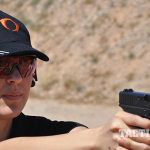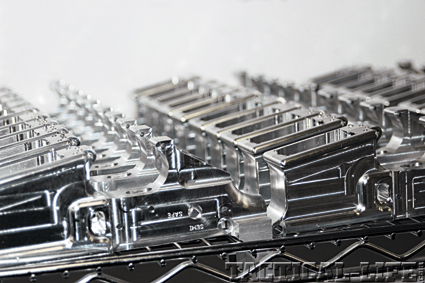https://cdn.athlonoutdoors.com/wp-content/uploads/sites/8/2015/05/gbg-accuracy-1-150×150.1511985468.png




Of all of the firearms in our arsenal, the handgun can be the most challenging to master. It is small with a short sight radius and generally has a trigger that requires more pressure than the gun weighs. Almost always found with “open sights,” mastering a handgun requires mastering many moving parts. Fear not though, because by dividing handgun shooting into a few sections, we can do pistol shooting drills to improve our overall shooting.
Trigger Control
We often hear the phrase “trigger control” used when discussions of accuracy arise. Few times, however, is it given sufficient attention. The truth is that pistols for the most part are accurate. It’s our manipulation of the weapon that interferes with its ultimate capability. Here are some solid trigger control drills to help you improve.
- RELATED STORY: 6 Tips For Improved Trigger Pull with Rob Leatham
Pistol Shooting Drill #1: Brass On The Front Sight
This is always easier with the help of a partner. Start by unloading your weapon and remove the magazine if possible. Reset the action on your pistol and have your partner balance a piece of spent brass on the front sight. Now, execute a smooth, clean press of the trigger. If you do this correctly, the front sight will not dip or move and the brass will stay in place. If the brass falls off, you are generally jerking the trigger and causing movement in the gun. That movement translates into missed shots. The key to keeping the brass steady is a smooth, continuous trigger press with a clean “break” at the end.
Pistol Shooting Drill #2: Keep the Slack Out
The more we move the trigger, the higher the probability that we will miss our shot. The trigger press is composed of three stages:
- The Slop – The distance the trigger travels to the rear before you encounter resistance.
- The Slack – The distance the trigger will still travel while under tension prior to firing.
- The Shot – Where the trigger finishes its travel and ultimately fires the weapon.
In our initial press of the trigger, we will experience all three stages of the trigger motion. However, after the initial press, the trigger will reset. The distance required for reset generally takes it only as far as our “slack” point. Do not allow the trigger to travel any further forward than necessary.
Pistol Shooting Drill #3: Empty Your Weapon and Press the Trigger
With your support-side hand, rack the slide and, as it is moving forward, relax your trigger finger. The tension of the trigger will push forward and allow it to reset. Only let the trigger move as far forward as it has to. Continuous dry-fire practice with this drill will familiarize you with how far your trigger needs to travel. We always look to avoid letting the trigger move all the way forward or having our trigger finger coming off. This generally ends up in a “slap” of the trigger on subsequent shots, which will interfere with accuracy.
Pistol Shooting Drill #4: Pencil Drill
Another common problem regarding the trigger is when it is not pressed directly to the rear. Many times, the firing-side hand over-grips the gun and causes the finger to arc as the trigger is pressed. This is called smearing the trigger and usually ends up causing shots to break to the support side. The trigger should be pressed with a direct and careful motion. A great pistol shooting drill to practice this is to place a pencil on the web of your thumb with the eraser on your trigger finger. Slowly and smoothly press the pencil toward you with the intention of keeping it on the web of the thumb. This drill will not only help you visualize a good press but can also create strong habits.
Follow-Through
Follow-through is the act of maintaining a steady platform to send follow-up shots on target. The challenge comes in the form of anticipation or flinch. Especially true with newer shooters, the anticipation of the next shot can cause a flinch response to the weapon. This causes muzzle dip, which never helps accuracy. Two proven drills to deal with this challenge are these:
Pistol Shooting Drill #5: Ball and Dummy
One of the most classic pistol drills, the Ball and Dummy drill is designed to help eliminate flinch. The drill is generally done with a partner to assist. While the shooter is turned away, the partner will place their weapon in a state of readiness. It will either be set with a round in the chamber or reset without a round. Either way, the trigger will function. The shooter is turned back around and given the weapon. They point in and press as if they were shooting a bullseye. If the weapon is unloaded, the trigger will click yet the muzzle should not dip. If there is a noticeable dip, it is a sign of anticipating the shot. Continue this drill with an occasional live round placed in the chamber so as to keep the shooter off-balance. Approximately 75 percent of the time it should be empty, however. This is a solid drill for learning to overcome the anticipation of the shot firing.
Pistol Shooting Drill #6: Single-Shot Drill
Similar to the Ball and Dummy drill, this exercise works on eliminating shot anticipation. This drill can be practiced without any assistance, making it easy to manage. Load one round into the weapon and then remove the magazine. Point in and fire the round on target. Settle in for a second shot and press the trigger. Watch your front sight intently for signs of dipping. This is equally effective as a tool for self-diagnosis.
Sight Picture & Alignment
There are many theories and methods of shooting when it comes to the sights. At the most fundamental and reliable level, though, we look to align the sights on target while intently focusing on the front sight. The rear sights should be slightly blurry as will be the target. The front sight should be crystal clear. Here are a few reliable drills to build confidence.
Pistol Shooting Drill #7: Bench Shooting
One of the best ways to learn certain components of shooting is to minimize the need to focus on other parts. By shooting from a benched position, you are able to eliminate the need to stabilize yourself in order to make good shots. This is a confidence builder as well as a drill to help you build good sight alignment habits. Sit at a bench with your arms resting on a shooting bag. Acquire a solid sight picture and alignment. Take your time and fire shots with the intent of managing perfect sights throughout the process.
Pistol Shooting Drill #8: Figure-8 Drill
One of the challenges we face is the feeling that our sights are all over the place as we begin to make a shot. For the most part, that is just our perception and not reality. With good mechanics, you can make accurate shots consistently. A drill to show you this, as well as to work on trigger control, is the Figure-8 drill. At about 6 yards, point in at your target, then take all of the slop and slack out of the trigger. Intentionally move the front sight 6 to 8 inches in a figure-8 over the bullseye. Now, as you come across the bullseye, break your shot and reset your trigger to shoot again. Continue this for 5 or 6 shots. What you will find is that you are much more accurate than you may think. By managing the trigger well, it allows for quite a bit of motion while still maintaining good accuracy.
Master Class
The goal is always to bring these components together. Unless you are a static bullseye shooter, there will be many moving parts to making a shot. Here are a few drills designed to start mixing components without overwhelming yourself.
Pistol Shooting Drill #9: Ragged Hole Drill
The Ragged Hole drill is another classic. From 6 yards, you will slow-fire 5 rounds into a single point on your target. Do your best to focus on a small portion of the target. Better yet, get a target that has 1- to 2-inch dots on it as focal points. Take your time and use the exact same point of aim each time. Do not chase your shots or try to make corrections. If you manage your trigger and sights well, you should end up with a single, ragged hole. If your shots are spread out, it is a sign that you need to polish up on one or more of the basics.
Pistol Shooting Drill #10: Shrinking Targets
Similar to the Ragged Hole drill, the goal here is to start shrinking your shot groups. Find or make a target that has 3 or 4 circles on it, each a little smaller than the previous one. From 6 yards, fire 5 rounds into each circle. The goal is to have all the rounds inside the circle. As you master one circle, move to the next smaller one, and so on. This is as much a confidence builder as it is a skill builder.
Pistol Shooting Drill #11: Single Shot From Draw
Our final drill starts to bring all of the fundamentals together. From a holstered position, smoothly draw your weapon and fire one round onto a bullseye. Do good after-action drills, then reholster. Repeat this 10 times and then reset yourself. The goal is to be able to shoot solid shots while mixing in the motion of drawing. If your groups begin to open up, slow down. If you are shooting ragged holes, then strive to increase your pace. This is a solid drill to start mixing the fundamentals.
Shooting a handgun can be a frustrating challenge. One minute you are shooting bullseyes and the next you are off. As with all shooting, it always comes back to the fundamentals. By practicing these pistol shooting drills, you can improve individual skills and ultimately bring them all together.
- RELATED STORY: Rifling 101: Understanding Twist Rate Basics
The post 11 Pistol Shooting Drills to Improve Accuracy appeared first on Tactical Life Gun Magazine: Gun News and Gun Reviews.
Tactical Life Gun Magazine: Gun News and Gun Reviews
 Cj comms open 1/6 slots (@ShiijeiKun)
Cj comms open 1/6 slots (@ShiijeiKun) 






 When one is responsible for promoting application development from Dev through the various environments such as QA, UAT, etc., through Production, it is often useful to ensure that configurations in test environments are comparable to the final production environment. This is especially true with systems where a team of DBAs manage the servers.
When one is responsible for promoting application development from Dev through the various environments such as QA, UAT, etc., through Production, it is often useful to ensure that configurations in test environments are comparable to the final production environment. This is especially true with systems where a team of DBAs manage the servers.


